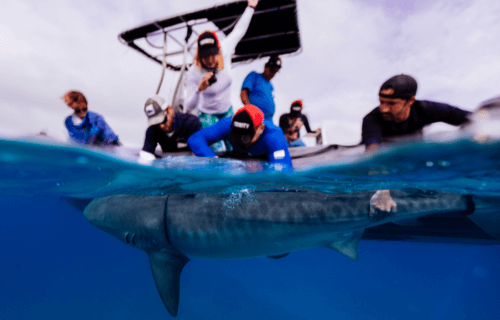WASHINGTON — Sharks are inching closer to extinction, even as the populations of other ocean species bounce back in recent year. An international team says the predators are continuing to struggle, while populations of tuna and billfish are coming back from the abyss.
The findings come from a review of these three species and their risk of extinction over the last 70 years — mainly as a result of overfishing.
“While target species such as tunas and billfishes are increasingly managed at sustainable levels, shark species taken as bycatch by the same fisheries continue to decline due to insufficient management actions,” says study author Dr. Maria José Juan-Jordá, according to a statement from SWNS.
The study found that commercially important tuna and billfish are recovering after decades of decline. However, sharks are facing extinction because of incidental capture by the same fisheries. The results reveal the urgency of implementing actions to prevent the increasing risk to endangered or threatened species.
The international team developed a new science-based indicator to assess the state of health of the oceans and their biodiversity. Its Red List Index (RLI) of predatory fishes is the first to measure the health of marine biodiversity farther from coastal areas. It monitors and analyzes annual changes over the past seven decades in the extinction risk of oceanic tunas, billfishes, and sharks.
“Our Red List Index shows trends in the extinction risk of oceanic predatory fishes, the sentinels of global ocean health,” Juan-Jordá tells SWNS. “This global indicator offers the bodies involved in the management if marine resources a very useful tool with a solid scientific basis to continue to make progress in the fight against the loss of biodiversity in marine ecosystems.”
Better management of the fishing industry could help sharks
The study, published in the journal Science, is based on the IUCN (International Union for Conservation of Nature) Red List Categories and Criteria. Experts analyzed historical data recorded by Regional Fisheries Management Bodies on 52 populations of 18 different species of tuna, billfish, and sharks.
The study also connects for the first time global annual changes in extinction risk with changes in fishing mortality over the past 70 years.
“The data show the global trajectory of changes in extinction risk in oceanic predatory fishes is highly sensitive and responds directly to fishing mortality,” the researcher says, according to SWNS.
“We also show a strong alignment between the current Red List status and the state of fisheries exploitation of tunas, billfishes and sharks derived from the most recent assessments when making these comparisons at the same scale.”
“We find mismatches among both assessments systems can be understood and explained,” Juan-Jordá adds.
The strong alignment between the Red List and fisheries assessments removes any technical barriers for policy makers to monitor global targets and commitments set by the Convention on Biological Diversity and the Sustainable Development Goals (SDGs) to halt and reverse marine biodiversity loss.
“The conservation statuses of threatened target species can be improved by managing the fishing industry, which can benefit the industry economically in the long run while allowing the threatened species to recover,” write Matthew Burgess and Sarah Becker in a media release. “However, the protection of high-vulnerability bycatch and nontarget species is expected to be more difficult because they will require fisheries to invest in better fishing gear and targeting practices, or reduce fishing efforts, without directly benefiting from these changes.”
Half of the world’s sharks are facing extinction
The methodology could also be applied to other marine fish, which would expand the representation of marine species on the IUCN Red List of Threatened species to monitor change in biodiversity more efficiently. The global population of sharks and rays has crashed by more than 70 percent in the past 50 years, with massive ongoing losses pushing many towards extinction.
A huge increase in fishing since 1970 has ravaged their abundance in our oceans, with previously widespread species such as hammerhead sharks now facing the threat of being wiped out completely.
Half the world’s 31 oceanic shark species are now listed as either “endangered” or “critically endangered” by the International Union for Conservation of Nature. The giant manta ray is also endangered.
South West News Service writer Mark Waghorn contributed to this report.

